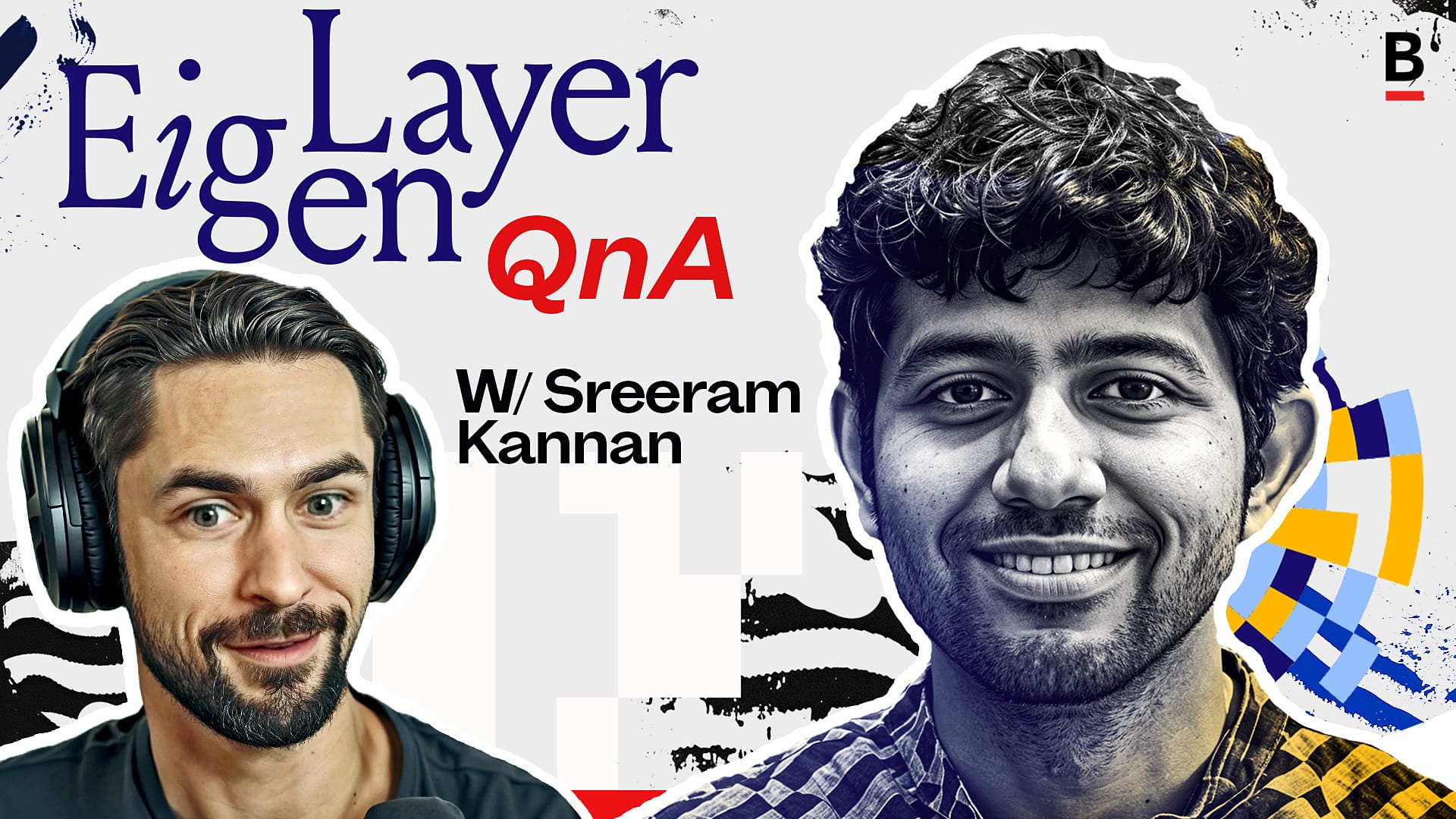EigenLayer represents a pivotal advancement for Ethereum, promising groundbreaking enhancements in security and accessibility — a claim that currently holds ~$7.5b at stake.
Amid excitement and optimism, critical voices – Vitalik himself included – have highlighted potential risks.
Proponents expect a restaking revolution, but others see a ticking time bomb.
This article attempts to dig into the risks EigenLayer has addressed, including potential pitfalls facing EigenLayer services and their operators, as well as the potential for systemic threats to  Ethereum L1Ethereum is a global platform for decentralized applications and finance.View Profile” class=”stubHighlight”>Ethereum as a network.
Ethereum L1Ethereum is a global platform for decentralized applications and finance.View Profile” class=”stubHighlight”>Ethereum as a network.
Let’s dive in
Welcome to Restaking Summer on Bankless
How big will the EigenLayer airdrop be?

What Risks Could EigenLayer Pose to Ethereum?
Fallout From Slashing
Spreading ETH stakes across EigenLayer’s services brings to light a critical concern about systemic vulnerabilities — the potential for fallout if there were widespread slashing events across all these services. Much ink has been spilled over these concerns, and rightfully so, but EigenLayer has detailed several strategies to combat this scenario.
- Pooled Security: By reallocating the same ETH stakes across multiple Actively Validated Services (AVSs), EigenLayer significantly strengthens its economic defenses. For instance, if the network restaked $1B across various AVSs, attacking any single AVS would require overcoming this sizable sum. Like in proof of stake, this capital shields against potential attacks.
- Attributable Security Mechanisms: As EigenLayer’s cornerstone, attributable security acts as an insurance mechanism, ensuring that penalties from slashing events will be redirected to compensate affected parties. For example, imagine a bridge acquires slashing redistribution rights for $25M. Now, if its operator faces a slashing, that penalty money will be redistributed back to the bridge to cover its losses. Even in a worst-case scenario where all validators attack a service, the smart contract ensures a portion of the losses can still be recouped.
- Economizing Security with Bundled Services: EigenLayer introduces an ‘Economy of Scale in attributable security’ feature, particularly advantageous for Layer 2 solutions requiring a suite of services. With ‘Economies of Scale,’ these services can be bundled together to be purchased with a discount. By bundling security purchases for services such as oracles, bridges, and sequencers, EigenLayer encourages enhancing protective measures against security breaches.
- Promoting a Diverse Validator Ecosystem: Central to EigenLayer’s risk mitigation strategy lies the promotion of validator diversity. Encouraging participation from validators across different regions who run different validator clients fortifies the network’s resilience against slashing and other security threats.
- Anti-Slashing Technology: EigenLayer prioritizes deploying anti-slashing tools that prevent validating slashable actions. Technologies such as those developed by Puffer, which allow for minimal collateral requirements, facilitate wider participation among solo stakers, further diversifying and bolstering the node operator network’s robustness.
Having understood how EigenLayer defends against slashing, a lingering question remains: Could these defenses inadvertently exacerbate centralization? Once again, though, EigenLayer prepared for this, developing several strategies to combat potential centralization. Let’s take a look.
The Bankless Guide to EigenLayer on Bankless
Updated: Dec 2023

Worsening Centralization
With EigenLayer’s computational demands causing worry that they may contribute to centralization and even Ethereum’s validator selection as a result, the protocol instituted several solutions — promoting easy-to-run AVSs, delegation demanding tasks, and potential incentives to lone validators — to prevent this and ensure widespread accessibility.
- Promoting “Computationally-Light” AVSs: By developing AVSs that require minimal computational power like EigenDA, EigenLayer’s inaugural AVS, the protocol aims to ensure that a diverse range of participants can contribute to the network.
- Delegation Features for Demanding Tasks: Eigenlayer’s delegation feature should allow participants without high-powered setups to pass the heavy computational lifting on to those more equipped, ensuring they still participate and receive rewards without having to upgrade their tech to complete those complex tasks.
- Economic Incentives for Solo Validators: EigenLayer provides incentives to solo validators, encouraging them to continue participating in the protocol and maintain a more decentralized, resilient network.
These strategies help alleviate centralization risks from EigenLayer’s computational demand. Thus, ![]() Eigenlayer RestakingEigenLayer: Decentralized marketplace for Ethereum operators to perform tasks securely.View Profile” class=”stubHighlight”>Eigenlayer does not contribute to Ethereum’s centralization in this way and, as a result, does not influence the selection of Ethereum’s validators. That authority remains with Mainnet’s decentralized governance, ensuring the network’s integrity and autonomy.
Eigenlayer RestakingEigenLayer: Decentralized marketplace for Ethereum operators to perform tasks securely.View Profile” class=”stubHighlight”>Eigenlayer does not contribute to Ethereum’s centralization in this way and, as a result, does not influence the selection of Ethereum’s validators. That authority remains with Mainnet’s decentralized governance, ensuring the network’s integrity and autonomy.
What are EigenLayer’s internal risks?
Stacking incentives in crypto can often lead to intended incentive flows falling out of whack. A potential conflict of interest in EigenLayer involves node operators who validate EigenLayer misusing restaked ETH for their own ends. Consider if Operator A, who not only operates an EigenLayer node but also holds a stake in a project on EigenLayer, faces a transaction that could harm their investment. This scenario highlights the potential for bias — an instance where the operator may act in their own interest as opposed to that of the network’s.
To steer clear of situations like this, EigenLayer employs several mechanisms to act as technical and economic safeguards:
- Technical Trust: With tools like Trusted Execution Environments (TEE) and anti-slasher systems in its hull, EigenLayer aims to ensure operator compliance with the network’s rules, not their personal interests.
- Economic Incentives: By requiring operators to stake tokens as a bond, EigenLayer aligns their fortunes with the network’s well-being. Stray from the course, and they risk their rewards, ensuring everyone stays on the same team.
- Decentralization of Control: EigenLayer champions a broad coalition of validators, diluting the power any single operator might hold. A strategy of decentralization acts as a bulwark against individual conflicts, ensuring a steady course for all – if they remain successful!
- Transparency and Community Oversight: EigenLayer maintains that validator maneuvers are under constant scrutiny by the network’s stakeholders, keeping everyone acting clean.
The above tactics will help EigenLayer mitigate conflicts of interest, safeguarding the validation process’s integrity.
At its core, EigenLayer is playing a game of chess with Ethereum’s future. It’s all about keeping computational demands in check, championing the lightweight approach with AVSs, making sure all can participate via delegation, and dangling the carrot of economic rewards to keep the solo validators motivated and involved. It’s a carefully crafted plan to fortify Ethereum’s ecosystem while sidestepping centralization.
EigenLayer’s blend of economic incentives, technological defenses, and public vigilance aims to provide a solid shield against the complexities of restaking. With mechanisms in place to protect against internal risks like conflicts of interest, and external risks like contributing to centralization on Mainnet, EigenLayer certainly has put serious effort toward scaling responsibly. As restaking stands on the brink of transforming Ethereum and crypto overall, grasping its potential implications proves essential.
The future is bright, but, as always, not without risk.
Eigenlayer Q&A with Founder Sreeram Kannan on Bankless
What are the biggest questions that people have about Eigenlayer? David sourced these questions from Crypto-Twitter, and asked Sreeram LIVE!

Read More: www.bankless.com










 Bitcoin
Bitcoin  Ethereum
Ethereum  Tether
Tether  XRP
XRP  Solana
Solana  USDC
USDC  Dogecoin
Dogecoin  Cardano
Cardano  TRON
TRON  Lido Staked Ether
Lido Staked Ether  Wrapped Bitcoin
Wrapped Bitcoin  Sui
Sui  Wrapped stETH
Wrapped stETH  Hyperliquid
Hyperliquid  Chainlink
Chainlink  Avalanche
Avalanche  Stellar
Stellar  Toncoin
Toncoin  LEO Token
LEO Token  Shiba Inu
Shiba Inu  Bitcoin Cash
Bitcoin Cash  Hedera
Hedera  Litecoin
Litecoin  USDS
USDS  WETH
WETH  Polkadot
Polkadot  Wrapped eETH
Wrapped eETH  Monero
Monero  Bitget Token
Bitget Token  Binance Bridged USDT (BNB Smart Chain)
Binance Bridged USDT (BNB Smart Chain)  Pepe
Pepe  Ethena USDe
Ethena USDe  Pi Network
Pi Network  Coinbase Wrapped BTC
Coinbase Wrapped BTC  WhiteBIT Coin
WhiteBIT Coin  Uniswap
Uniswap  Aave
Aave  Dai
Dai  Bittensor
Bittensor  NEAR Protocol
NEAR Protocol  Aptos
Aptos  OKB
OKB  Jito Staked SOL
Jito Staked SOL  BlackRock USD Institutional Digital Liquidity Fund
BlackRock USD Institutional Digital Liquidity Fund  Ethena Staked USDe
Ethena Staked USDe  Ondo
Ondo  Cronos
Cronos  Tokenize Xchange
Tokenize Xchange  Internet Computer
Internet Computer